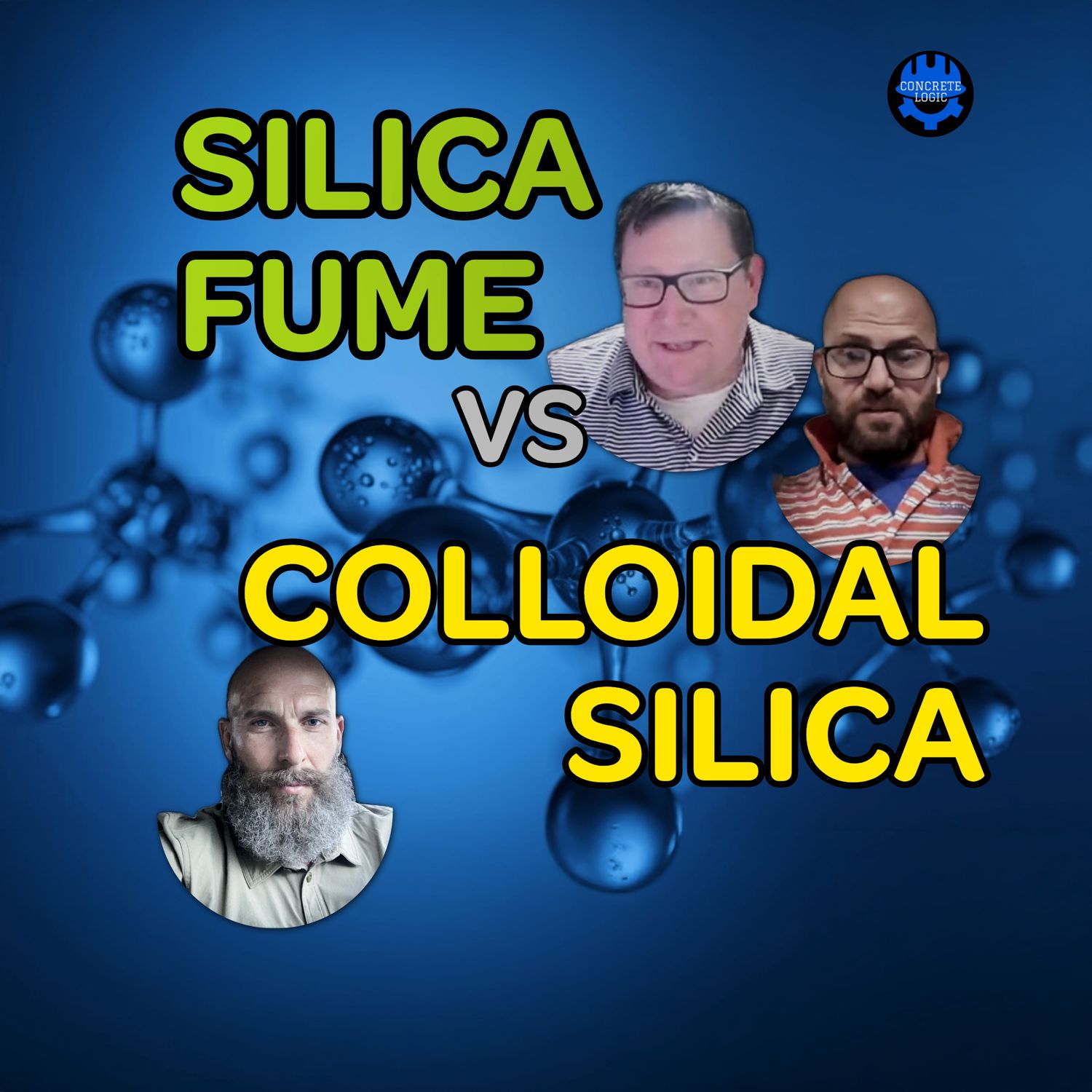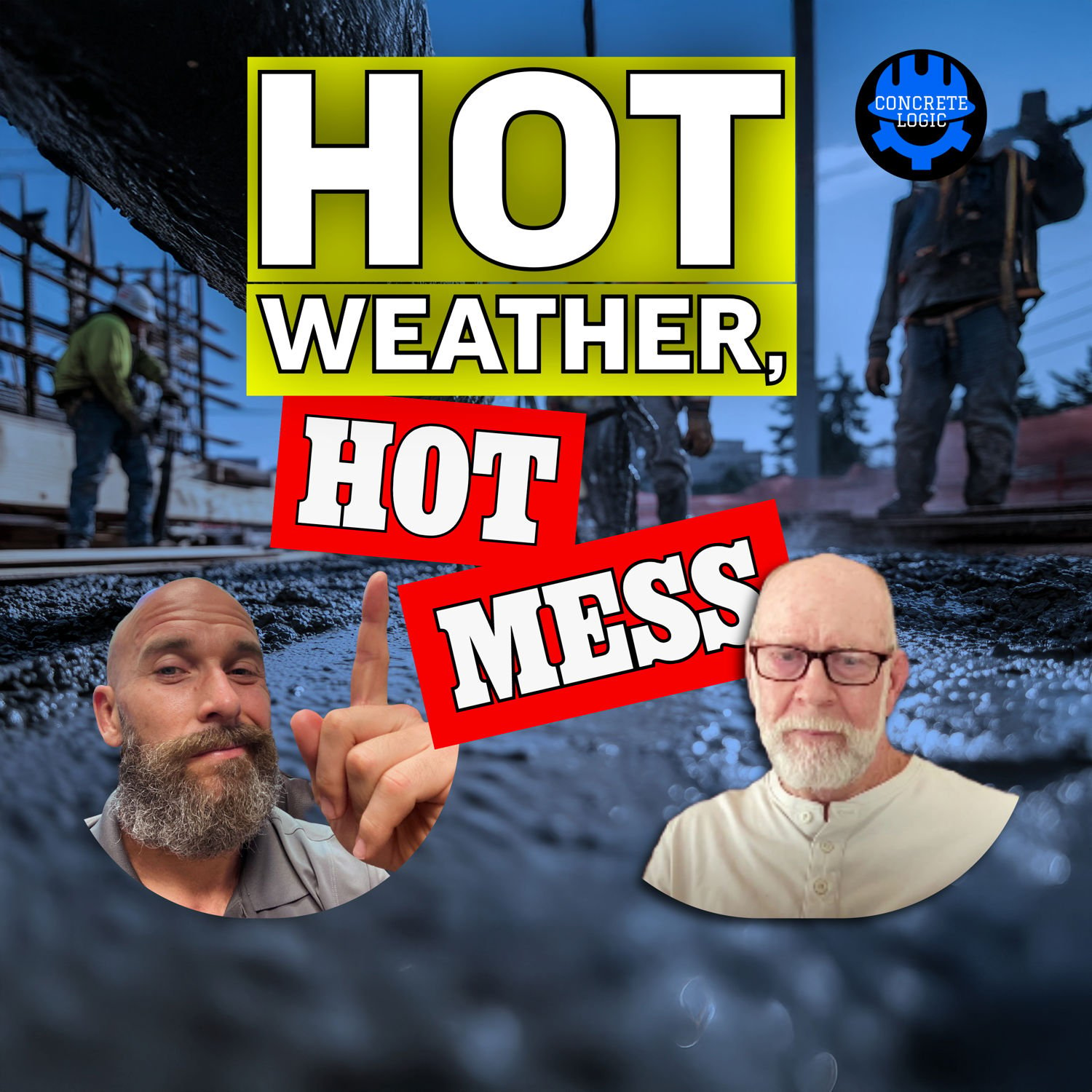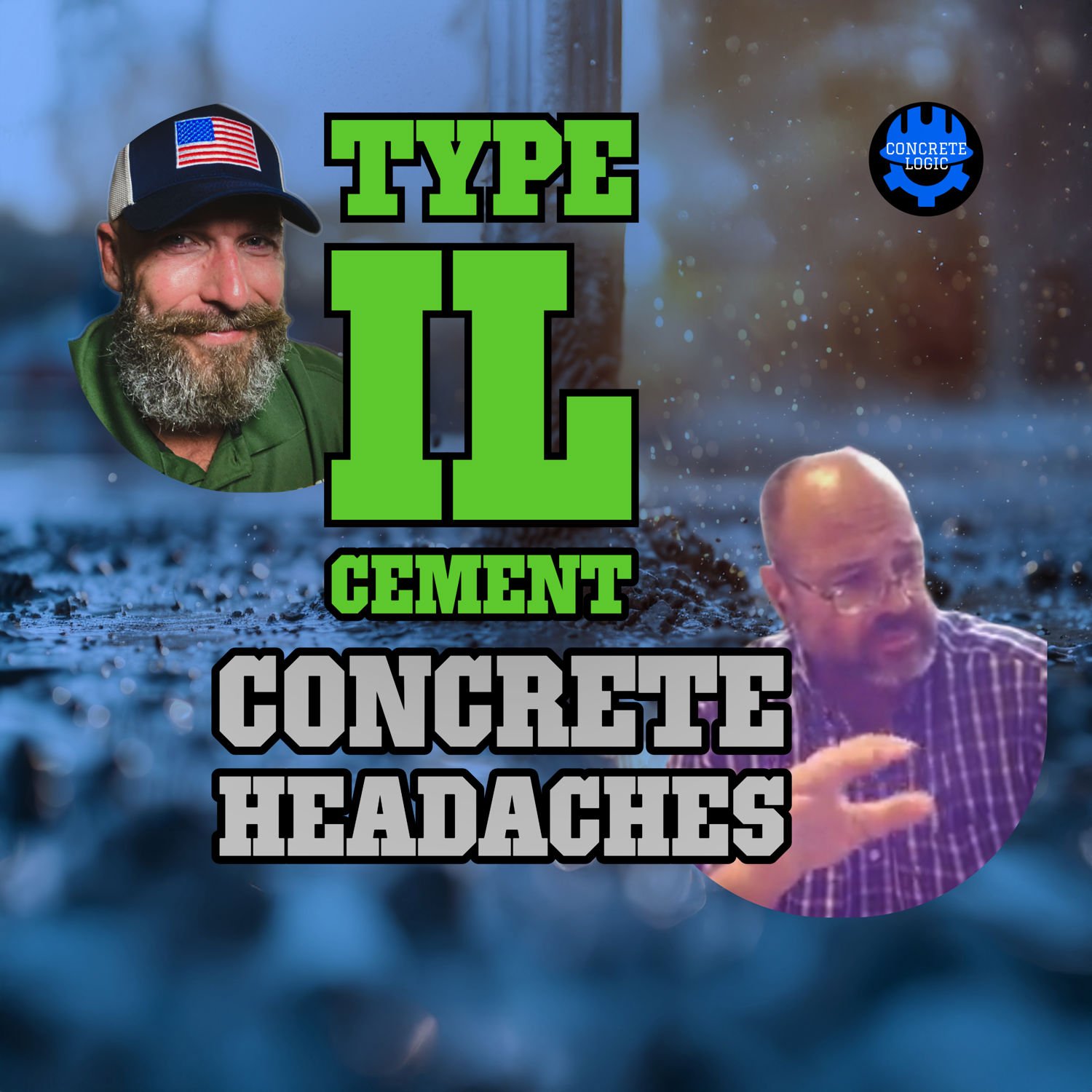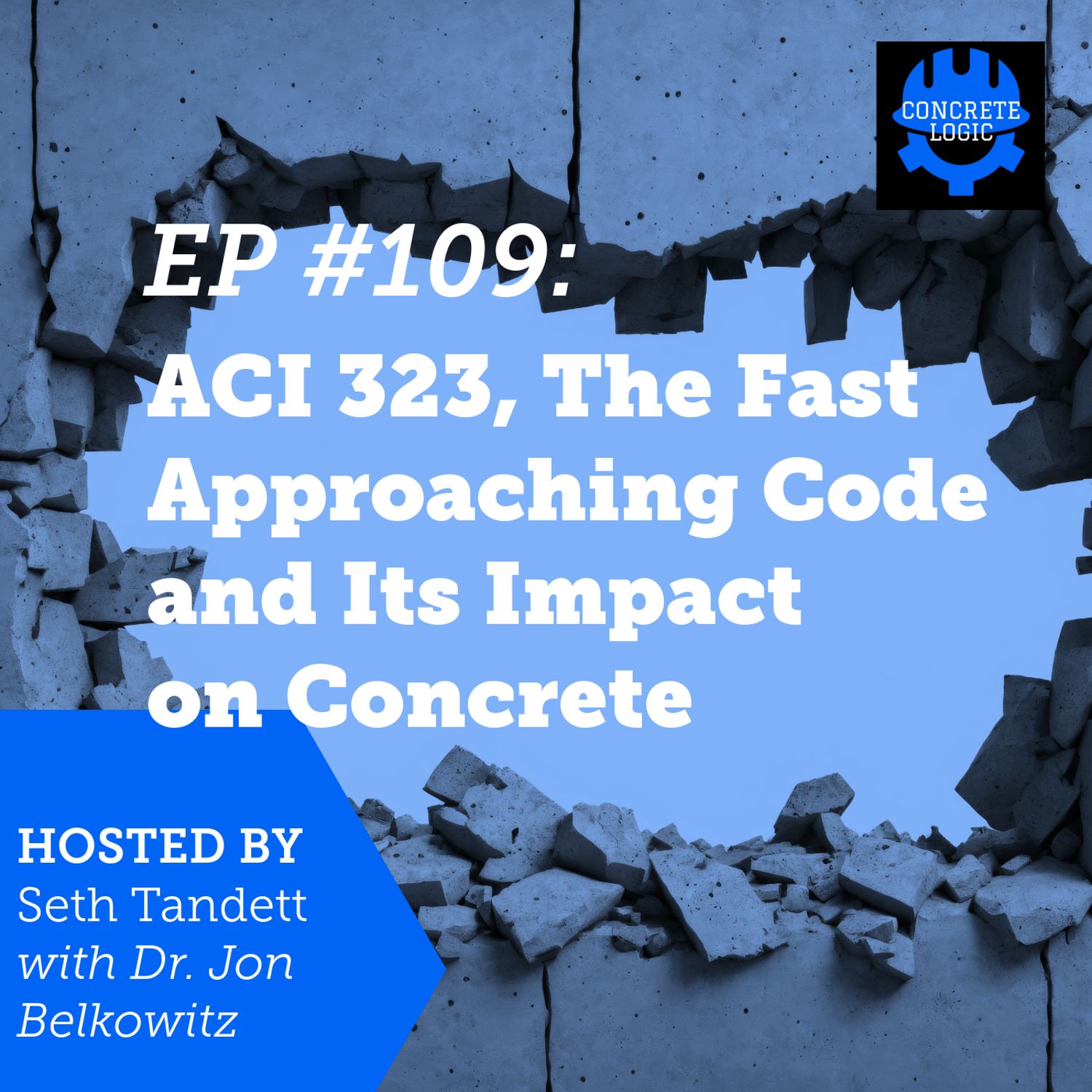EP #117: Boosting Concrete Testing Accuracy with the CTAC Program
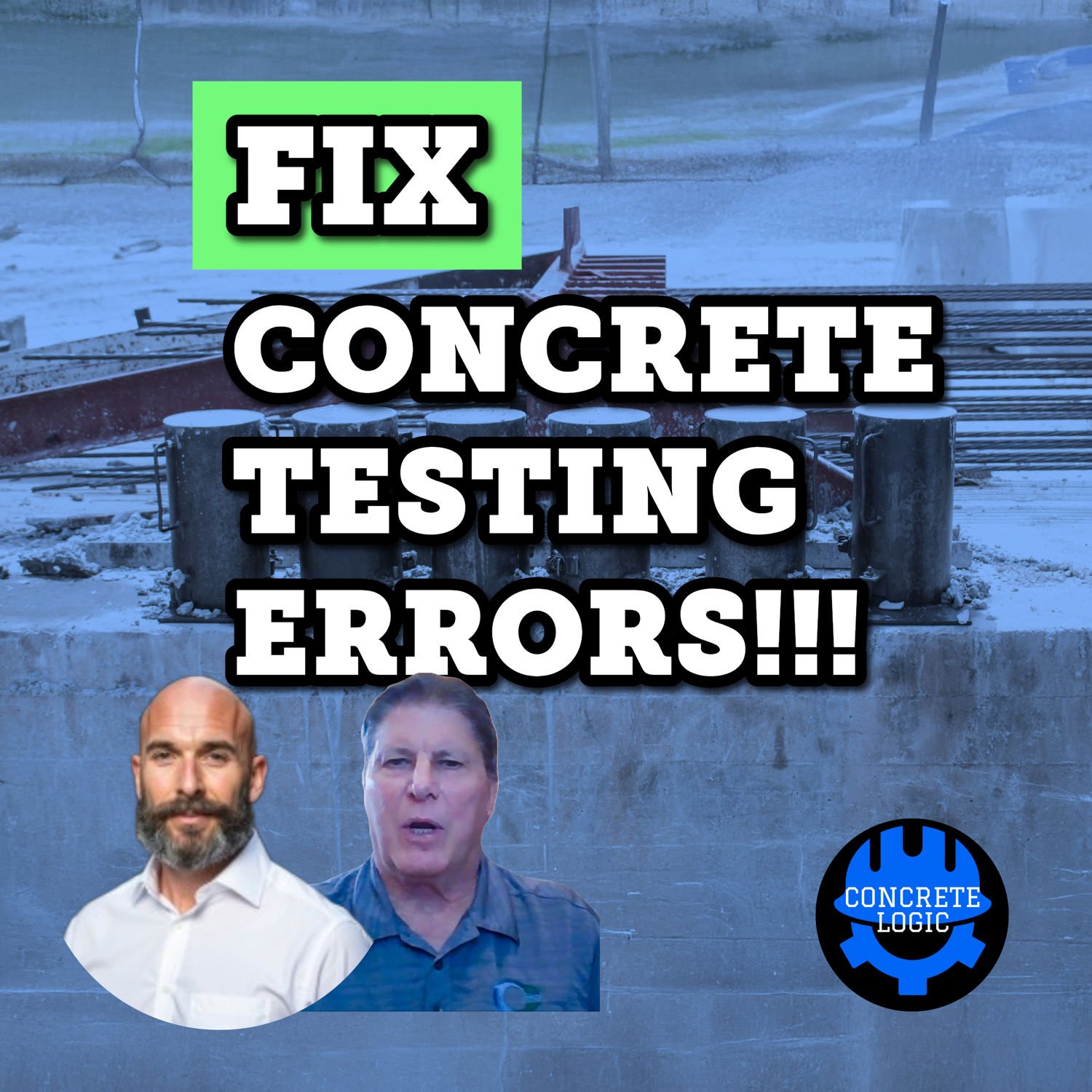
In this episode, Seth Tandett talks with Todd Ohlheiser, Executive Director of the Colorado Ready Mixed Concrete Association (CRMCA), about the CTAC Program (Concrete Testing Adherence Collaboration Program). Todd explains how this program helps ensure that concrete cylinders are properly tested and cured, addressing common mistakes that lead to low strength results. They also discuss the role of ACI-certified technicians, the importance of correct testing, and how the program benefits contractors and suppliers by improving the accuracy of concrete testing.
🔎 What’s Inside:
✔️ The importance of proper cylinder curing and testing
✔️ Why the CTAC Program is essential for concrete contractors and suppliers
✔️ How improper testing can lead to over-design and unnecessary cement usage
✔️ A breakdown of the CTAC program's 4 critical observations
✔️ The role of ACI-certified technicians in ensuring accurate tests
✔️ The future of the CTAC program and its plans for broader adoption
📈 CHAPTERS:
00:00 – Introduction to Todd Ohlheiser and the CTAC Program
02:00 – The Role of Testing Cylinders in Concrete Quality
04:00 – The Impact of Improper Curing on Concrete Strength
05:00 – How the CTAC Program Works: 4 Simple Observations
08:00 – The Problem of Low Strength Results and How CTAC Helps
11:00 – Real-World Applications of the CTAC Program in Concrete Projects
14:00 – The Future of Concrete Testing and Lowering Carbon Emissions
17:30 – How the Program Has Improved Training for Field Technicians
20:00 – Key Benefits for Contractors Using the CTAC Program
23:00 – How to Get Involved and Implement the Program in Your Area
25:00 – Closing Thoughts: Improving the Industry Together
🎧 LISTEN NOW – A MUST for anyone in the concrete industry!
👨👩👦 Guest: Todd Ohlheiser | Executive Director, CRMCA & CSSGA
📧 Email: todd@crmca.org
📍 Guest Website: https://www.crmca.org
=============================
This video is NOT sponsored. Some product links are affiliate links, which means if you buy something, we'll receive a small commission.
=============================
📚 Recommended Resources:
CTAC Program: Learn more about the program here: https://www.concretetac.com
ACI Field 1 Certification: Understanding concrete testing standards: https://shorturl.at/EBP5S
💪 Take Your Knowledge Further – Join Concrete Logic Academy!
Gain exclusive access to expert video courses, live Q&A, and cutting-edge industry insights. Earn Professional Development Hours (PDHs) and elevate your expertise!
📍 Learn More: https://www.concretelogicacademy.com
💸 Support the Podcast – Be Part of the Concrete Revolution!
Donate: https://www.concretelogicpodcast.com
Become a producer & get recognized on our next episode!
Producers: Jodi Tandett
🎶 Music by: Mike Dunton
🌐 Website: https://www.mikeduntonmusic.com/
👀 Stay Connected & Watch More!
👉 Host: Seth Tandett
💌 Email: seth@concretelogicpodcast.com
👥 LinkedIn: https://www.linkedin.com/in/seth-tandett/
📺 YouTube Channel: https://www.youtube.com/c/ConcreteLogicPodcast
🌐 Podcast Website: https://www.concretelogicpodcast.com
🚀 LIKE, SUBSCRIBE & SHARE for more expert concrete insights!
#ConcreteLogic #ConcreteTesting #ConcreteIndustry #CTAC #KeepItConcrete
Seth Tandett (00:00)Welcome to another episode of the Concrete Logic Podcast. And today I have Todd Ohlheiser with CRMCA, which is Colorado Ready Mixed Concrete Association. Did I get that right, Todd? yeah. And as well, he's the executive director for CRMCA, as well as the Colorado Stone, Sand, and Gravel Association.Todd Ohlheiser (00:13)You got it right, perfect.Seth Tandett (00:23)Since 2013, prior to that, he spent many years in the construction, concrete and aggregate mining industry, managing businesses and operations in both the US and Canada. Currently, Todd oversees both associations in an effort to positively impact legislative and regulatory issues. And Todd is a certified association. He has a...a certified association of executive and holds a master's degree in organizational leadership from Colorado State and a couple other things, man. You got a list of degrees here. It's very good. But today, the reason why you're tuning in today is we're going to talk about the C-TECH program, which is a concrete testing adherence collaboration program to helpTodd Ohlheiser (00:58)It's cool, man. It got a long rap sheet, Seth.Seth Tandett (01:13)improve testing accuracy. So one of our favorite subjects to talk about is testing cylinders. So those samples that we take at the job and those cylinders have a lot to do with the day-to-day operation of a concrete contractor, concrete ready mix supplier. So this is a great topic and you will get a lot from today's discussion.So Todd, I know we talked a little bit before we hit start and we were going to explain what the Concrete Testing Inherence Collaboration Program is, but first let's talk about, so we're all on the same page, let's talk about these testing cylinders. Let's explain what they are and then we can talk about what the program isTodd Ohlheiser (01:59)And first off, thanks for the invitation and the opportunity to go on your podcast. And you've got a lot of good sessions out there. So thank you very much. Yeah, so we, you know, I worked for the Ready Mix industry, right? That was, that's the initial role. And so there was a lot of frustration regarding what happens to their cylinders.and so forth and what happens on fresh concrete testing. So everyone has a as an example, everyone has a driver's license, but you also have a driving record. And if you're certified to test, there is no way of tracking and seeing if you're doing it right. so we started with a program to do that. You had mentioned cylinders, the the care of those cylinders.and especially regarding initial curing has the biggest single impact on the final strength. So as you know, the cylinders meet the certain strength, compressive strength, and that's for acceptance of the concrete. Those cylinders have to be treated per the standards, and that is, you know, obviously the concrete's collected correctly, the slump is measured and everything else.But again, when those cylinders are cast, they have to be in an initial curing environment from 60 to 80 degrees, depending on the strength, for an initial period of time. If they're not, that has the single largest impact on the final strength outcome 28 days later. So that's a big part of our message, and that is different from contractors or others that want to put cylinders underneath the blankets or whatever.and see what's going on with the slab. That's perfectly fine, but that is totally separate from the acceptance cylinders on that the municipalities, contractors and so forth require on the job. So that's where we started to just say, how do we track that? How do we get our arms around that and kind of track what's going on because it has a huge impact.Seth Tandett (03:59)Yes. So yeah, I mean, if you've been, I mean, I would think anybody that's been in the industry for any amount of time, I mean, even young guys and gals out there that have only been on the, a, you know, maybe one project or two, but the testing cylinders, I mean, it's at least at one time on a job, it comes up, it's a subject of debate and stress andeverything like that. this is a great program. I saw some post on LinkedIn. Actually, I saw there's a Canadian group that was kind of rolling this out too. Is that correct? were doing... Yeah. Yeah, it was like we were giving out... It was like giving out a speeding ticket to testing agencies is what it looked like to me.Todd Ohlheiser (04:31)Concrete Association of Ontario. Yes, that's correct.They've transitioneda little bit to their own hybrid program, but that's what they're doing. They're letting people know, hey, look, it's not done per the standard. So awareness is a big part of any improvement. And so that's how they're doing it. So everybody's trying different ways as well to make people aware and raise the tide, raise the bar.Seth Tandett (05:06)So this is the look at how the third party testing agency is performing those tests that we need and what are the tests that we need that this program is overseeing.Todd Ohlheiser (05:17)Yeah, so the ACI field one observation. So everyone, there's thousands and thousands of people that are ACI certified and that includes, you know, again, gathering the sample per the standard, running the air test, running the slump, running the temperature. You know, obviously there's, those are the main ones and then casting that cylinder and putting it in that protected environment.So everyone does most of those right, so we track all of them. We have four simple questions that came out of this and so a person can pull up the, you know, a small tool on their phone or whatever and log in and say, is the sample obtained correctly? Yes or no? There's no really area in between. Is the technicianACI certified yes or no Have the field tests been conducted per the standard There's a drop down that you know one for air one for temperature and so forth But if they're all done correctly you just click yes and question four is have the cylinders in a proper curing environment initial curing environment, which means is there a thermometer in thereprotected from the elements are they going to be at 60 to 80 and so it's all done per that day we do not have a way to tie back to the strength the final strength 28 days later this is what happens on site and so that's that's what we're trying to get our arms around is what happens on site the of those items I just mentioned step everything in life is the 80 20 rule80 % of the problems are on question number four. Has initial curing been done properly? And I'm here to tell you that with thousands of data points across the country, I don't think that question number four comes back correctly, but maybe 20 % of the time. I mean, it's shocking. Primarily, there's no thermometer in there. There's no, so we don't know if those cylinders were done.correctly if there's no thermometer and so forth. they in a, you know, a cure box? Could be. And it's not always the tester, right? Sometimes the cure box, the power to the generator turned off over the weekend. And so that cure box is either freezing or, you know, 120 degrees inside that box. So again, those are the steps we monitor. So we have since, we have two series of, I guess,observers. One is those four questions and that person has to be ACI field one certified to be an approved observer. And so it's garbage in garbage out. So you know we initially talked about do we want ready mix drivers on jobs to be observers. Well they're not certified so that we don't know that they are aware of what they're looking at.Seth Tandett (07:53)Okay.Todd Ohlheiser (08:07)But then we've since now about six months ago gone to a system where you can just log in and answer question number four. I am not currently field one certified, but I can take a little quiz that we have and watch a little video and then I'm authorized to be a field observer. So this allows superintendents.maybe city inspectors, you know, anyone else that passes a shorter quiz to be one of the observers for initial curing, which again is the biggest issue that the industry is dealing with. And there's obviously a lot of ramifications if those strengths are coming in artificially too low, not to mention the impact on over design andwhere we're trying to go with lowering carbon and so forth now, you know what happens. People aren't going to deal with low strengths, what do they do? Add cement. That's what the industry is doing.Seth Tandett (09:05)Yeah, you're not supposed to tell our secrets. So you hit on how someone could fill out the question number four related to the cure, but if someone wants to be a C-TECH observer, what is the qualification for doing the whole thing? What do you have to have to be an observer?Todd Ohlheiser (09:08)I know.Yeah, good question. Thanks for asking. you have to be ACI field one certified and at least six months of experience. But what they do then, so let's Martin, Mary, well, there's a lot of companies using it. don't want to really single any out, but it would be in a positive note because some are using it very effectively.So if it's in Texas, Texas is one of our partners, we go through the state associations. So my partners through the Colorado Ready Mix Association are in that case, TACA, right? So the Texas is a partner of ours, pay us an administrative fee and then their members can use this for free or however they're set up. All of them are doing it free at this point.For their members so when they have a person contractor or anyone in Texas They they send us I've got an admin or Actually a PE running this program send him a request that that our rep for TACA Says hey, I want to add this guy to an observer list and there's maybe 40 or 50 in in Texas then then weJT Masit is my guy's name looks that up says we're good. He's in the system Do you want to watch a little training video and off he goes? So that's how we get people on board But it's through the partners which include again some some big states, Texas, you know, California Minnesota Well quite a few but but that's how we set up our partners and so but we doWe do work with other state associations.Seth Tandett (11:03)Okay. So what have how long has the program been around?Todd Ohlheiser (11:07)Well, it was, I think it started in like 15 or something, but we started filling out paper forms and so forth. just wanted to, so it's transitioned as most things have with technology. But so I don't know what year we launched it. I think it was about a year and a half ago we started to go, we broadened it to these other states and so.Seth Tandett (11:27)So it's relatively new, it's safe to say. What has been the feedback that you've gotten so far? And can you share some examples of where this has actually reduced the normal chaos that happens when someone gets a low strength test result?Todd Ohlheiser (11:49)Yeah, well, you know, just let me answer or kind of twist a little bit on that point. When someone does that, there's a lot of frustration. There's a lot of tension and finger pointing and who screwed up. And of course, the first thing that's going to happen is you're going to be coring done because you don't want to be tearing that out. And now the project is, of course, 28 to 30 some days old, that poor. And so, you know, there's things a lot of things have happened. SoSeth Tandett (11:57)Mm-hmm.Todd Ohlheiser (12:19)So obviously that's underway. But I will tell you this, that we've had some, I guess, misconceptions with this program that people thought that it was going to take care of the problem. this only works with companies that use it. It only works with those who help themselves. So if I'm a ReadyMix producer,And I have my one of my certified technicians out there on a job observing this. And I know it's going to be a high spec job. It's a high rise in our case, downtown Denver, you know, 40 story building. Hey, it's or out at the airport or whatever the case may be. I can set that up and track these. And then we have the ability to pull up a monthly report or whatever frequency people want.Say look here's what's going on on this job. So we start we we can't we Originally started with a short form of the NRM CA pre-construction checklist Make sure that's done up front and then follow through and as you know, the checklist has to be Where's the cure box gonna be who what's the what's the company? Are they certified things like that? And so then right awaybefore the whole project gets too deep, you can do this after one week, after one observation and that red flag goes up and go, know, hey, Seth, on your job with Baker, it's not going per the standard. There's no, guess what? There's no care box. There's no this and that. Now, not so maybe so much on higher spec jobs that the Bakers of the world do.but you can imagine all the job sites out there where it's not really focused on. So it allows that communication to occur. Things still have to change. This is a tracking tool. It's not the magic pill. It allows for some documentation and things of that nature to bring the awareness level up and remind people, hey,This is a recipe for disaster. Our breaks are likely to be coming out low 28 days from now. And let's address it now. And those that use it in that manner, it's tremendously successful. Those that do some observations and keep that information to themselves, it's probably just another layer of frustration.Seth Tandett (14:35)Mm-hmm. Some more paperwork to do. Yeah.Todd Ohlheiser (14:39)Yeah, yeah, exactly. And thepoor field technician, you know, or and or she is out there doing that and they're busy. They're two jobs behind, you know, there and the weather isn't cooperating. And the last thing they want to do is stick around and do a side by side test by by somebody else. But, you know, again, it's it only helps those who help themselves. So.Once, and if those are done initially on a project and you get those addressed, look, you don't have to be out there doing those side by sides all the time. They can go off to the next job.Seth Tandett (15:13)As far as the third party testing agency, the technicians and all that, what has been maybe something or a result of this program that you didn't expect from them? it... I guess the... I actually heard this this week, I shared with you that I've had conversations about testing cylinders and the...the lack of following the right procedure has led to low breaks. Has this shined a light on how important that job is? I think people second-handly just think this is not important. It's just something we have to do to make so we can get the concrete into the pump or up on the deck or into the bucket.We got to let this person do these tests and that's it. It doesn't have any importance or, you know, it's just something that we have to do. So I'm just curious if doing this program, people that are participating in this are pointing out this is important, this is very important, this job that you're doing, and then maybe the third party agencies are now...Hiring differently maybe or spending more time training these people before they put them out? I... Go ahead, I'm sorry. Yeah. Okay.Todd Ohlheiser (16:38)Yeah, no, that's exactly right. All of the above attimes, right? So it could go a number of ways. First of all, what we see is the good labs use it to get better. You had mentioned training and so forth. There's a few of them that use it for training and they can monitor what's going on. There are guys out there in the field. can pull this down. They can pull information on an employee by employee basis.One thing I want to add here is that industry cannot see what is going on with a lab, right? Only they can. So they can see themselves against the industry average, but this is not a scorecard to where you can go on the CTAQ website and say, I want to compare labs and I want to pair. That is not what...It's for and what is available. So there's no comparison, but yeah, people can use it to train their people say, hey, seems to be an issue here on a couple, you know, on slump or something. Do we need a refresher on that? Many times it's not the lab that doesn't, there's still questions. You're a big time contractor company and there's still questions about.who's responsible for the power to the cure box? Who's responsible for the cure box at times and so forth? it just, it does raise the level of awareness and forces people to have those discussions because doing nothing is wrong, right? I mean, the only thing that, so, you what I say also about the program is that,It's not the cure-all. does help those who help themselves. But, you know, it's... You have to use the tool and then if you do, it will, you know, it'll help you in many ways in the future, right? JT's got a great comment that he copied from some movie that he likes in that there is no problem until there's a problem.And that is what we're talking about with initial curing is that there's you just referred to that Seth. Well, it's no one takes it very serious. It's it's gray and it gets hard. Right. What's the problem here? And that's that's it. So there's some ignorance. And and and, you know, ignorance to me is not, you know, we're not dealing with people that aren't smart. They're very smart, but they don't know what they don't know about the importance of those cylinders.and what what needs to happen with them so it is you know it has been taken for granted and has been taken for granted well over fifty years we we started a when i took over i ended up looking through some old old board of directors notes and honest to god there was a note in there that said there was some discrepancies on the testing and they believe that thetesting wasn't done correctly. Now this was 1972 before there was ACI standard certifications, but 1972 the Colorado Ready Mixed Concrete Association has a record of low breaks due to improper field testing. So, and I'm sure that's not the first time, right?Seth Tandett (19:39)Yeah. So what are, what you said the, the curing is the biggest problem, the way they're carrying the cylinders. What, what are you seeing that is the most often, maybe the top two or three mistakes that you're seeing that's happening over and over again?Todd Ohlheiser (19:55)Yeah, well, you know, one thing that we allow in this app is taking pictures and you would be surprised at how many cylinders are just still sitting behind the curb or sitting on the corner. They're there, you know, so they're not in the proper environment. And then the next thing is that there is no min max thermometer in there. So you have no idea exactly what's happening to that cylinder. SoSo those are the two most common in that, you know, no box, no protective equipment, and then, you know, or put them in a bucket and fill the bucket half full of water and assume that's gonna work. again, it's just more people not knowing the significance of not doing it right. then again, many believe apparently based on the observations that, well, if I put it in a box, I'm good.and don't need a min max thermometer and things of that nature. again, it's just assumptions like you stated.Seth Tandett (20:52)Okay, what's the plans? What's the future of the program?Todd Ohlheiser (20:58)Yeah, so we talked about job by job. We're redoing our program. We've got we've got general stats, right? We've got thousands of data points across, you know, east to west now. They don't they won't help Baker Concrete. General stats are just that they're general and it's somebody else's problem. This is my opinion now. But what we we are redoing ourProgram in our front end to where people can and I'll again I'll just keep keep using Baker if it's okay Baker the con Company Can go in and set up the job that you want you can determine? You know what what jobs you want to observe? And so forth so what we need to do is really get this more user-friendly on the front end. It's a bitclunky now, will tell you that. collects, does a great job of collecting data. People love the simplicity of the app itself. But then this information dump is, we need to get that readily available to concrete producers, to contractors. And by the way, I just want to say, you know, one of the big pushes we just started six months ago, and shame on me for not doing it earlier.To deal more with the contractors. We started to you know interact with you know ASCC who you know is obviously a huge group and Mike Hernandez actually turned us turn me on to what you're doing and and so You know the contractors have just as much skin in the game as the ready mix producer so and and and a same with the city inspector and things of that nature, so that'swe're starting to reach out to those groups as well and say, you should be interested too in what's going on on your job. And the other part that we're dealing with, you talk about the future, is this lower carbon push. NRMCA, who we do a lot of partnering with, we love NRMCA.When Karthik was there, his stats said that 11 % cement consumption was based on over design due to improper testing. 11 % and that is huge, but you know, contractors, ready mix producers and so forth, the last thing they can have is a low break. It's just not gonna fly. So they have to treat it differently and that's not the future.That is something that we need to do everything correctly and then, you know, I mean, imagine pulling 11 % out just by doing it right. And that's again, statistically, but it's a huge number.Seth Tandett (23:33)Yeah, we would. Yeah, if folks that are listening, you definitely want to reach out to Todd and get involved with this program. I think this is pretty, pretty easy to start on your own. But I mean, it's just the four observations. So even if you know, there's not a program in their state time, wouldn't you wouldn't they be able to do something very similar?Todd Ohlheiser (23:55)Yeah, we're working out the bugs on that. I should have probably had that ironed out. In fact, I just talked to Mike Hernandez two days ago on how we're going to do this because we want to deal with the large contractors. And so we're working on that. I would say at this point, I would encourage people to go through their state association. They are listed on our concrete tack website, concrete testing it here.collaboration so it's it's under concrete tack.org and and gather that but but short of that just reach out to me or JT Masit who you'll see on that website as well and we'll we're we're making some things work one-off right now this allows companies to go across state lines we had some companies that were working inMinnesota and going south, you know, the same group, crew of course is going to go down into Iowa and so forth. Well, you don't want to deal with a whole separate deal all the time. we've made that change. So we are making changes as necessary to make this as easy as possible to be used.Seth Tandett (25:09)Yeah, yeah, it's a great program. It seems like very simple to make such an observation and to stem these type of problems from happening. So I think it's a great program. I'm so happy you came on the show and shared this. Just shout out to Mike Hernandez for connecting Todd and I up. Mike with the AESCC group.Todd, I appreciate you coming on the show today. We'll put all the contact information for Todd and the CTAC program in the show notes. So you'll want to check out the show notes, go through there and we'll put all the appropriate links and contact information for you so you know how to reach to Todd. Todd, thank you for coming on the show today. Appreciate it.Todd Ohlheiser (25:49)Thank you, it's my pleasure.Seth Tandett (25:51)All right, until next time, folks, let's keep it concrete.

Todd Ohlheiser
Executive Director
Todd Ohlheiser has been Executive Director for the CRMCA, as well as the Colorado Stone, Sand & Gravel Association (CSSGA) since 2013. Prior to that, he spent many years in the construction, concrete, and aggregate mining industry managing businesses and operations the both US and Canada. In the current capacity, Todd oversees both associations in an effort to positively impact legislative & regulatory issues, continuously drive safety, and drive overall improvement within the ready mixed concrete industry.
Todd is a Certified Association Executive and holds a Masters Degree in Organizational Leadership from Colorado State University, a B. S. in Business Administration from Regis University and an Associate Degree in Mechanical Engineering from the North Dakota State College of Science.









